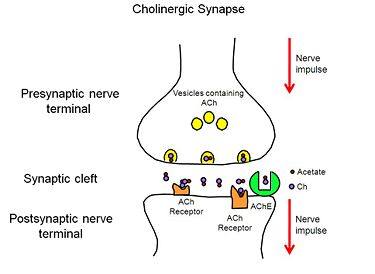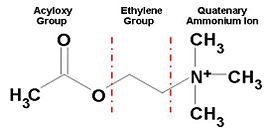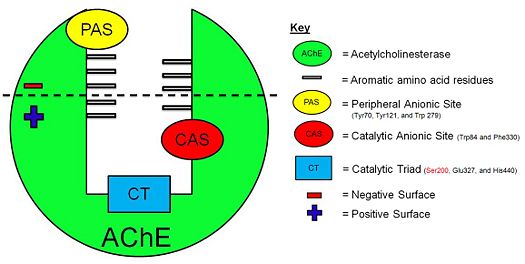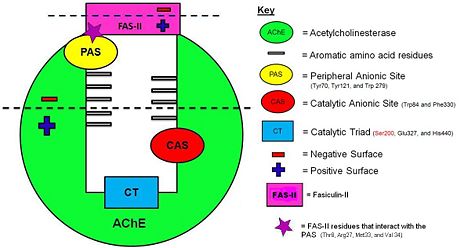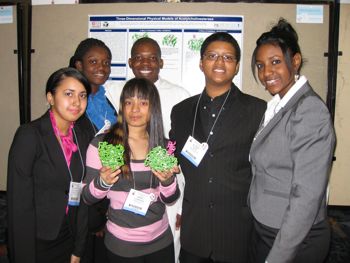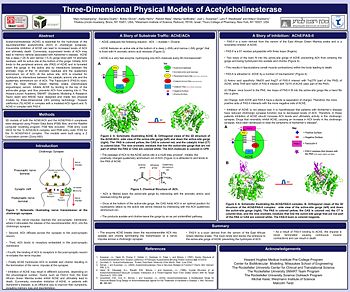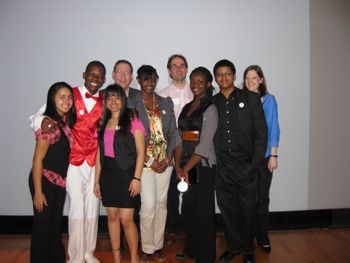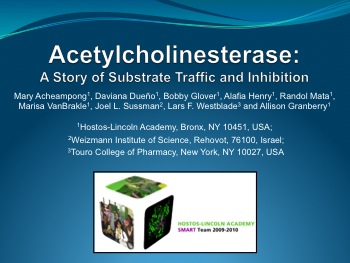Sandbox 997
From Proteopedia
(→'''Introduction''') |
(→'''Physical Models of Acetylcholinesterase in Complex with Acetylcholine and the Green Mamba Snake Toxin, Fasciculin-II''') |
||
| Line 9: | Line 9: | ||
| - | =='''Introduction'''==<StructureSection load='2ace' size='500' side='right' caption='Structure of HMG-CoA reductase (PDB entry [[1dq8]])' scene=''>Anything in this section will appear adjacent to the 3D structure and will be scrollable. | + | =='''Introduction'''==<StructureSection load='2ace' size='500' side='right' caption='Structure of HMG-CoA reductase (PDB entry [[1dq8]])' scene=''>Anything in this section will appear adjacent to the 3D structure and will be scrollable. |
Acetylcholinesterase(AChE) is essential for the hydrolysis of the neurotransmitter acetylcholine(ACh), and therefore the termination of the nerve impulse in cholinergic synapses. Irreversible inhibition of AChE can lead to increased levels of ACh in cholinergic synapses and ultimately death. Conversely, suppressed levels of ACh may lead to memory deficits associated with Alzheimer's disease. AChE has a deep(20Å) and narrow(5Å) gorge lined with 14 aromatic residues, with its active site at the bottom of the gorge. Initially, ACh binds to the peripheral anionic site(PAS) of AChE and is funneled down the gorge to the active site by interactions between the aromatic rings of the 14 aromatic residues and the quaternary ammonium ion of ACh. At the active site, ACh is oriented for hydrolysis by interactions between the catalytic anionic ion site and the quaternary ammonium ion of ACh. The Fasciculin-II (FAS-II)toxin, a component of the East African Green Mamba snake(''Dendroaspis angusticeps'') venom, inhibits AChE by binding to the top of the active-site gorge, including residues that form the PAS; thus preventing ACh from entering the active-site gorge. The Hostos-Lincoln Academy Students Modeling A Research Topic(S.M.A.R.T) team and the Center for BioMolecular Modeling have designed and fabricated two physical models using a combination of computational molecular modeling and three-dimensional(3D) printing technology: ''Torpedo californica''(''Tc'') AChE in complex with a modeled ACh ligand and ''Tc''AChE in complex with FAS-II. | Acetylcholinesterase(AChE) is essential for the hydrolysis of the neurotransmitter acetylcholine(ACh), and therefore the termination of the nerve impulse in cholinergic synapses. Irreversible inhibition of AChE can lead to increased levels of ACh in cholinergic synapses and ultimately death. Conversely, suppressed levels of ACh may lead to memory deficits associated with Alzheimer's disease. AChE has a deep(20Å) and narrow(5Å) gorge lined with 14 aromatic residues, with its active site at the bottom of the gorge. Initially, ACh binds to the peripheral anionic site(PAS) of AChE and is funneled down the gorge to the active site by interactions between the aromatic rings of the 14 aromatic residues and the quaternary ammonium ion of ACh. At the active site, ACh is oriented for hydrolysis by interactions between the catalytic anionic ion site and the quaternary ammonium ion of ACh. The Fasciculin-II (FAS-II)toxin, a component of the East African Green Mamba snake(''Dendroaspis angusticeps'') venom, inhibits AChE by binding to the top of the active-site gorge, including residues that form the PAS; thus preventing ACh from entering the active-site gorge. The Hostos-Lincoln Academy Students Modeling A Research Topic(S.M.A.R.T) team and the Center for BioMolecular Modeling have designed and fabricated two physical models using a combination of computational molecular modeling and three-dimensional(3D) printing technology: ''Torpedo californica''(''Tc'') AChE in complex with a modeled ACh ligand and ''Tc''AChE in complex with FAS-II. | ||
---- | ---- | ||
| Line 197: | Line 197: | ||
---- | ---- | ||
---- | ---- | ||
| + | </StructureSection> | ||
==='''References'''=== | ==='''References'''=== | ||
Current revision
Physical Models of Acetylcholinesterase in Complex with Acetylcholine and the Green Mamba Snake Toxin, Fasciculin-II
Students: Mary Acheampong. Daviana Dueño, Bobby Glover, Alafia Henry, Randol Mata, and Marisa VanBrakle, Hostos-Lincoln Academy.
Teacher: Allison Granberry, Hostos-Lincoln Academy
Mentors: Joel Sussman, Weissman Institute of Science, and Lars Westblade, Touro College of Pharmacy.
| |||||||||||
References
1. Sussman, Joel L., Harel M., Frolow, F., Oefner, Christian, Goldman, Adrian, Toker, Lilly, Silman, Israel (2006). Atomic Structure of Acetylcholinesterase form Torpedo californica: A Prototypic Acetylcholine-Binding Protein in Science 253, 872-879.
2. Goodsell, David, “Acetylcholinesterase.” Protein Data Bank: Molecule of the Month. Web. June 2004.
3. Silman, Israel, Sussman, Joel L. (2008). Acetylcholinesterase: How is Structure Related to Function? In Chemico-Biological Interactions 175(3-10).
4. Harel, Michal, Kleywegt, Gerrad J., Ravelli, Raimond B.G., Silman, Isreal, Sussman, Joel (1995). Crystal Structure of an Acetylcholinesterase-Fasciculin Complex: Interaction of a Three-Fingered Toxin From Snake Venom With Its Target in Structure 3(12), 1355-1366.
5. Greenblatt, Harry M., Dvir, Hay,Silman, Isreal, Sussman, Joel L. (2002). Acetylcholinesterase: A Multidaceted Target for Strucutre-Based Drug Design of Anitcholinesterase Agents for the Treatment of Alzheimer’s Disease in Journal of Molecular Neuroscience 20, 369-383.
Acknowledgements
1. Howard Hughes Medical Institue Pre-College Program
2. Center for BioMolecular Modeling, Milwaukee School of Engineering
3. The Rockefeller University Center for Clinical and Translational Science
4. The Rockefeller University S.M.A.R.T Team Program
5. The Rockefeller University Science Outreach Program
6. Touro College of Pharmacy
7. Michal Harel, Weizmann Institute of Science
8. Malcolm Twist
